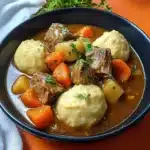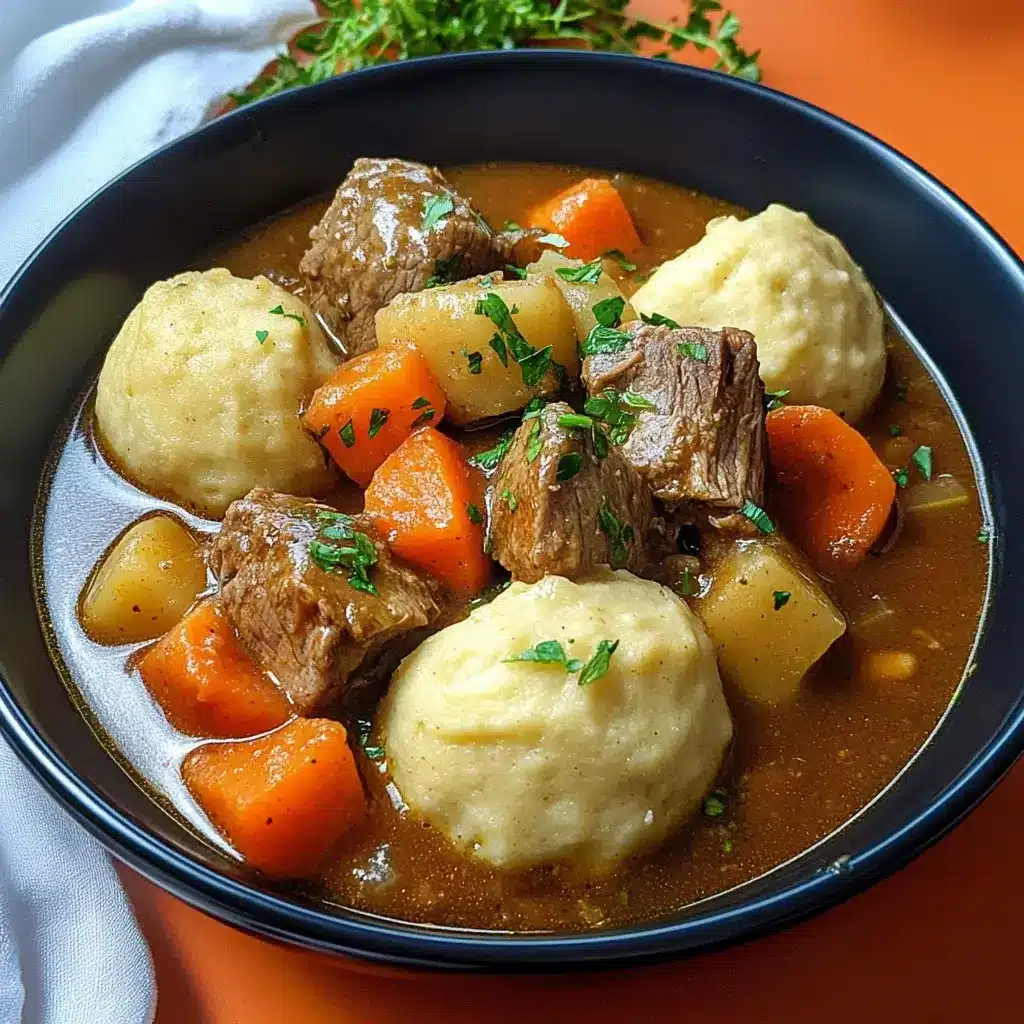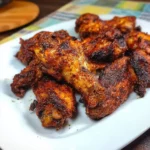There are few dishes in this world that can conjure a sense of pure, unadulterated comfort quite like a homemade Beef Stew and Dumplings. For me, the aroma alone is a time machine. It takes me back to chilly, rain-lashed Sundays, the windows fogged with warmth, and the promise of a meal that feels like a hug in a bowl. I remember the first time I truly perfected this recipe. I had been chasing the memory of my grandmother’s stew for years—a stew with beef so tender it melted on the tongue and dumplings that were impossibly light and fluffy, like savory little clouds floating on a rich, savory sea. After much trial and error, I finally cracked the code: the secret was in the slow, patient browning of the meat, the deep flavor built by deglazing the pot with red wine, and a dumpling recipe so simple yet so precise. I served it to my family on a particularly cold winter evening. The silence that fell over the table, punctuated only by the clinking of spoons against bowls, was the highest compliment I could have ever received. This isn’t just a recipe; it’s a legacy, a pot full of warmth and love that I’m thrilled to share with you.
The Ultimate Beef Stew and Dumplings: A Comfort Food Classic
Welcome to what will undoubtedly become your go-to recipe for the most robust, flavorful, and soul-satisfying beef stew you have ever made. This is more than just a meal; it’s an event. We are going to build layers of deep, complex flavor from the ground up, resulting in incredibly tender, fall-apart beef and a rich, velvety gravy. And the crowning glory? Light, airy, herb-flecked dumplings, steamed to perfection right on top of the stew, ready to soak up every last drop of the delicious sauce. This one-pot wonder is the perfect dish for a cozy family dinner, a weekend project, or any time you need to serve up a bowl of pure, unadulterated comfort.
Why This Recipe is the Gold Standard
In a world of countless stew recipes, this one stands head and shoulders above the rest. Here’s why:
- Unparalleled Flavor Depth: We don’t just toss ingredients in a pot. We take the time to develop flavor at every single stage: searing the beef for a deep brown crust (the Maillard reaction), sautéing the aromatics until sweet, cooking down tomato paste for umami richness, and deglazing the pot with red wine to capture every last flavorful morsel.
- Melt-in-Your-Mouth Tender Beef: The secret to truly tender beef isn’t a mystery; it’s about choosing the right cut and using the right technique. We use beef chuck, a cut rich in connective tissue that breaks down during a long, slow simmer, transforming into luscious, gelatinous tenderness that makes the meat incredibly moist and flavorful.
- The Fluffiest, Lightest Dumplings: Say goodbye to dense, heavy, or gummy dumplings. This simple, foolproof recipe creates pillowy, cloud-like dumplings every time. We’ll share the secrets to a light hand and the all-important “no-peek” rule for perfect steaming.
- A True One-Pot Meal: While it tastes like a gourmet production, this entire dish—from searing the meat to steaming the dumplings—is made in a single Dutch oven or heavy-bottomed pot. This means richer flavor (as nothing is lost between pans) and, most importantly, minimal cleanup.
Ingredients for the Perfect Stew and Dumplings
The quality of your ingredients will directly impact the final dish. Here’s everything you’ll need to create this masterpiece.
For the Hearty Beef Stew:
- Beef: 3 pounds of beef chuck roast, cut into 1.5-inch cubes
- Flour: 1/3 cup of all-purpose flour
- Salt & Pepper: 1.5 teaspoons of kosher salt and 1 teaspoon of freshly ground black pepper (for the beef)
- Fat: 2 tablespoons of olive oil and 2 tablespoons of unsalted butter
- Aromatics: 2 large yellow onions, chopped; 3 large carrots, peeled and cut into 1-inch pieces; 3 celery stalks, cut into 1-inch pieces
- Garlic: 6 cloves of garlic, minced
- Tomato Paste: 3 tablespoons of tomato paste
- Red Wine: 1.5 cups of a dry red wine, such as Cabernet Sauvignon, Merlot, or Pinot Noir
- Broth: 4 cups of low-sodium beef broth
- Herbs: 2 sprigs of fresh thyme, 1 sprig of fresh rosemary, 2 dried bay leaves
- Potatoes: 1.5 pounds of Yukon Gold or red potatoes, cut into 1-inch chunks
- Peas: 1 cup of frozen peas
For the Fluffy Herb Dumplings:
- Flour: 2 cups of all-purpose flour
- Baking Powder: 4 teaspoons of baking powder
- Salt: 1 teaspoon of kosher salt
- Butter: 4 tablespoons of cold, unsalted butter, cut into small pieces
- Milk: 1 cup of whole milk or buttermilk
- Fresh Herbs: 3 tablespoons of finely chopped fresh chives or parsley
Step-by-Step Instructions
Patience is a key ingredient in this recipe. Follow these steps carefully to build the layers of flavor that make this stew truly exceptional.
Step 1: Prepare and Sear the Beef (The Most Crucial Step!)
Pat the beef cubes completely dry with paper towels. This is essential for getting a good sear. In a bowl, toss the beef cubes with the 1/3 cup of flour, 1.5 teaspoons of salt, and 1 teaspoon of pepper until evenly coated.
In a large Dutch oven or heavy-bottomed pot, heat the olive oil and butter over medium-high heat. Once the butter is melted and the fat is shimmering, add the beef to the pot in a single layer. Do not crowd the pan! Work in 2-3 batches to ensure the beef sears rather than steams. Brown the beef cubes deeply on all sides, about 2-3 minutes per side. This deep brown crust (the Maillard reaction) is where a massive amount of flavor comes from. As each batch is browned, transfer it to a separate plate and set aside.
Step 2: Sauté the Vegetables
Reduce the heat to medium. Add the chopped onions, carrots, and celery (the “mirepoix”) to the pot. Sauté for 8-10 minutes, stirring occasionally, until the vegetables have softened and the onions are translucent. Add the minced garlic and cook for another minute until fragrant.
Step 3: Deglaze and Build the Rich Broth
Add the tomato paste to the pot. Stir it into the vegetables and cook for 2 minutes, allowing the paste to darken slightly in color. This cooks out the raw tomato flavor and deepens its umami taste.
Pour in the red wine to deglaze the pot. Use a wooden spoon to scrape up all the precious browned bits (the “fond”) from the bottom of the pot. This is pure flavor! Let the wine simmer and reduce by about half, which should take about 5 minutes.
Step 4: The Slow Simmer for Tenderness
Return the seared beef and any accumulated juices back to the pot. Pour in the beef broth and add the fresh thyme sprigs, rosemary sprig, and bay leaves. Stir everything together. Bring the stew to a boil, then reduce the heat to low, cover the pot with a tight-fitting lid, and let it simmer gently for 2 hours. The low, slow simmer is what breaks down the connective tissue in the beef, making it incredibly tender.
Step 5: Add Potatoes and Continue Simmering
After 2 hours, stir in the cubed potatoes. Place the lid back on and continue to simmer for another 45-60 minutes, or until both the beef and potatoes are fork-tender.
Step 6: Prepare and Cook the Fluffy Dumplings
About 15 minutes before the stew is finished, prepare the dumpling dough. In a medium bowl, whisk together the 2 cups of flour, 4 teaspoons of baking powder, and 1 teaspoon of salt. Add the small pieces of cold butter. Using your fingertips or a pastry blender, cut the butter into the flour until the mixture resembles coarse crumbs.
Stir in the chopped fresh chives or parsley. Pour in the milk or buttermilk and stir with a fork just until a soft, shaggy dough forms. Do not overmix! Overmixing will develop the gluten and result in tough, dense dumplings.
Step 7: The Grand Finale – Steaming the Dumplings
Remove the lid from the stew. Remove the herb sprigs and bay leaves. Stir in the frozen peas. Increase the heat slightly to ensure the stew is at a steady, gentle simmer (not a rolling boil). Drop heaping tablespoonfuls of the dumpling dough directly onto the surface of the simmering stew, leaving a little space between each one.
Immediately cover the pot with the tight-fitting lid. Reduce the heat to low and let the dumplings steam for 15-18 minutes. DO NOT PEEK! Lifting the lid releases the steam that is essential for cooking the dumplings and making them light and fluffy. After 15 minutes, you can insert a toothpick into the center of a dumpling; it should come out clean.
Step 8: Serve and Enjoy
Carefully ladle the hot stew and a few dumplings into warm bowls. Garnish with a sprinkle of extra fresh parsley or chives and serve immediately.
Nutrition Facts
This is a hearty, comforting meal. Nutritional information is an approximation and can vary.
- Servings: This recipe generously serves 6-8 people.
- Serving Size: 1 serving
- Calories per serving (approximate): 700-850 kcal (includes stew and dumplings)
Preparation Time
- Prep time: 30 minutes
- Cook time: 3.5 – 4 hours
- Total time: Approximately 4 – 4.5 hours
How to Serve Beef Stew and Dumplings
This dish is a complete meal in a bowl, but here are a few ways to present it perfectly.
- In a Rustic Bowl: The best way to serve this dish is simply ladled into a deep, rustic-style ceramic bowl that keeps it warm.
- With a Side Salad: To balance the richness of the stew, serve it alongside a simple green salad with a bright, acidic vinaigrette.
- Garnish Generously: A final sprinkle of fresh, vibrant green parsley or chives not only adds flavor but also provides a beautiful color contrast to the rich brown stew.
- Offer Crusty Bread: While the dumplings are perfect for sopping up the gravy, some people can’t resist a slice of warm, crusty bread on the side for extra dipping potential.
5 Additional Tips for Absolute Perfection
- The Right Cut of Beef is Everything: Do not be tempted to use expensive, lean cuts like sirloin or tenderloin for this stew. They lack the fat and connective tissue (collagen) needed for a long, slow braise and will turn out dry and tough. Beef chuck is your best friend here. Brisket or round roast are also good alternatives.
- The Secret to Fluffy Dumplings is a Light Touch: The two cardinal sins of dumpling making are overmixing the dough and peeking while they steam. Mix the dough only until it just comes together; lumps are okay! And once that lid is on, set a timer and walk away. Trust the process.
- For an Even Thicker Gravy: This stew naturally thickens from the flour on the beef and the starches from the potatoes. If you prefer an even thicker, gravy-like consistency, you can make a simple cornstarch slurry. At the end of cooking (before adding the dumplings), whisk 2 tablespoons of cornstarch with 3 tablespoons of cold water in a small bowl. Stir this slurry into the simmering stew and let it cook for a minute or two until thickened.
- Make it in a Slow Cooker: You can easily adapt this recipe for a slow cooker. Follow steps 1-3 on the stovetop to brown the meat and build the flavor base. Then, transfer everything (except the potatoes and peas) to your slow cooker. Cook on low for 6-8 hours or on high for 3-4 hours. Add the potatoes during the last 2 hours of cooking. To make the dumplings, turn the slow cooker to high, add the peas, drop the dumplings on top, cover, and cook for the final hour without peeking.
- It Tastes Even Better the Next Day: Like most stews, the flavor of this dish deepens and improves overnight as the ingredients meld. You can make the stew portion a day ahead. When ready to serve, bring it to a simmer on the stovetop and proceed with making and steaming fresh dumplings.
Frequently Asked Questions (FAQ)
1. Why was my beef stew meat tough and chewy?
There are two likely culprits: you either used the wrong cut of beef (a lean cut instead of chuck), or you didn’t cook it long enough. Braising is a low-and-slow process. If the meat is tough, it almost always just needs more time for the connective tissue to break down. Give it another 30-60 minutes of simmering.
2. Can I make this beef stew without the red wine?
Yes, you can. While the wine adds a significant layer of flavor and complexity, you can substitute it with an equal amount of extra beef broth. To mimic the acidity of the wine, you can add 1-2 tablespoons of balsamic vinegar or a tablespoon of Worcestershire sauce along with the broth.
3. My dumplings were dense and soggy on the bottom. What went wrong?
This usually happens if the stew is not simmering actively enough when you add the dumplings. The dough sinks into the liquid instead of sitting on top to steam. Ensure your stew is at a lively, gentle simmer before dropping the dough. A rolling boil can be too vigorous, but a lazy bubble won’t be enough to cook them properly.
4. Can I freeze Beef Stew and Dumplings?
The stew portion freezes exceptionally well. Let it cool completely and store it in an airtight, freezer-safe container for up to 3 months. However, the dumplings do not freeze and reheat well; they tend to become dense and mushy. The best method is to freeze the stew by itself. When you’re ready to eat, thaw the stew, bring it to a simmer on the stovetop, and make a fresh batch of dumplings to steam on top.
5. Can I use a different type of potato?
Yukon Gold or red potatoes are recommended because they are “waxy” and hold their shape well during the long cooking time. You can use starchy potatoes like Russets, but be aware that they will break down more and act as a natural thickener, which will result in a thicker, less brothy stew and less distinct potato chunks.

Delicious Beef Stew and Dumplings recipe
Ingredients
- Beef: 3 pounds of beef chuck roast, cut into 1.5-inch cubes
- Flour: 1/3 cup of all-purpose flour
- Salt & Pepper: 1.5 teaspoons of kosher salt and 1 teaspoon of freshly ground black pepper (for the beef)
- Fat: 2 tablespoons of olive oil and 2 tablespoons of unsalted butter
- Aromatics: 2 large yellow onions, chopped; 3 large carrots, peeled and cut into 1-inch pieces; 3 celery stalks, cut into 1-inch pieces
- Garlic: 6 cloves of garlic, minced
- Tomato Paste: 3 tablespoons of tomato paste
- Red Wine: 1.5 cups of a dry red wine, such as Cabernet Sauvignon, Merlot, or Pinot Noir
- Broth: 4 cups of low-sodium beef broth
- Herbs: 2 sprigs of fresh thyme, 1 sprig of fresh rosemary, 2 dried bay leaves
- Potatoes: 1.5 pounds of Yukon Gold or red potatoes, cut into 1-inch chunks
- Peas: 1 cup of frozen peas
For the Fluffy Herb Dumplings:
- Flour: 2 cups of all-purpose flour
- Baking Powder: 4 teaspoons of baking powder
- Salt: 1 teaspoon of kosher salt
- Butter: 4 tablespoons of cold, unsalted butter, cut into small pieces
- Milk: 1 cup of whole milk or buttermilk
- Fresh Herbs: 3 tablespoons of finely chopped fresh chives or parsley
Instructions
Pat the beef cubes completely dry with paper towels. This is essential for getting a good sear. In a bowl, toss the beef cubes with the 1/3 cup of flour, 1.5 teaspoons of salt, and 1 teaspoon of pepper until evenly coated.
In a large Dutch oven or heavy-bottomed pot, heat the olive oil and butter over medium-high heat. Once the butter is melted and the fat is shimmering, add the beef to the pot in a single layer. Do not crowd the pan! Work in 2-3 batches to ensure the beef sears rather than steams. Brown the beef cubes deeply on all sides, about 2-3 minutes per side. This deep brown crust (the Maillard reaction) is where a massive amount of flavor comes from. As each batch is browned, transfer it to a separate plate and set aside.
Reduce the heat to medium. Add the chopped onions, carrots, and celery (the “mirepoix”) to the pot. Sauté for 8-10 minutes, stirring occasionally, until the vegetables have softened and the onions are translucent. Add the minced garlic and cook for another minute until fragrant.
Add the tomato paste to the pot. Stir it into the vegetables and cook for 2 minutes, allowing the paste to darken slightly in color. This cooks out the raw tomato flavor and deepens its umami taste.
Pour in the red wine to deglaze the pot. Use a wooden spoon to scrape up all the precious browned bits (the “fond”) from the bottom of the pot. This is pure flavor! Let the wine simmer and reduce by about half, which should take about 5 minutes.
Return the seared beef and any accumulated juices back to the pot. Pour in the beef broth and add the fresh thyme sprigs, rosemary sprig, and bay leaves. Stir everything together. Bring the stew to a boil, then reduce the heat to low, cover the pot with a tight-fitting lid, and let it simmer gently for 2 hours. The low, slow simmer is what breaks down the connective tissue in the beef, making it incredibly tender.
After 2 hours, stir in the cubed potatoes. Place the lid back on and continue to simmer for another 45-60 minutes, or until both the beef and potatoes are fork-tender.
About 15 minutes before the stew is finished, prepare the dumpling dough. In a medium bowl, whisk together the 2 cups of flour, 4 teaspoons of baking powder, and 1 teaspoon of salt. Add the small pieces of cold butter. Using your fingertips or a pastry blender, cut the butter into the flour until the mixture resembles coarse crumbs.
Stir in the chopped fresh chives or parsley. Pour in the milk or buttermilk and stir with a fork just until a soft, shaggy dough forms. Do not overmix! Overmixing will develop the gluten and result in tough, dense dumplings.
Remove the lid from the stew. Remove the herb sprigs and bay leaves. Stir in the frozen peas. Increase the heat slightly to ensure the stew is at a steady, gentle simmer (not a rolling boil). Drop heaping tablespoonfuls of the dumpling dough directly onto the surface of the simmering stew, leaving a little space between each one.
Immediately cover the pot with the tight-fitting lid. Reduce the heat to low and let the dumplings steam for 15-18 minutes. DO NOT PEEK! Lifting the lid releases the steam that is essential for cooking the dumplings and making them light and fluffy. After 15 minutes, you can insert a toothpick into the center of a dumpling; it should come out clean.
Carefully ladle the hot stew and a few dumplings into warm bowls. Garnish with a sprinkle of extra fresh parsley or chives and serve immediately.
Nutrition
- Serving Size: one normal portion
- Calories: 700-850





